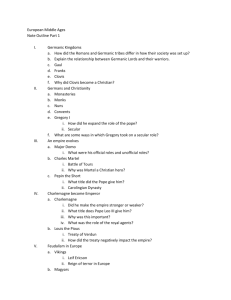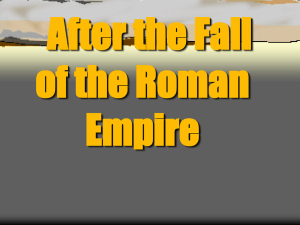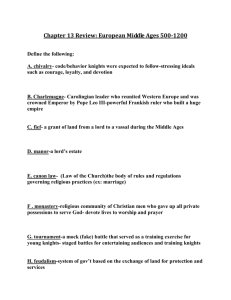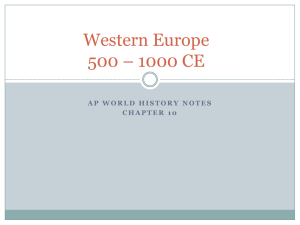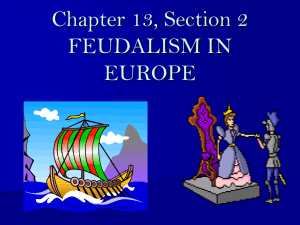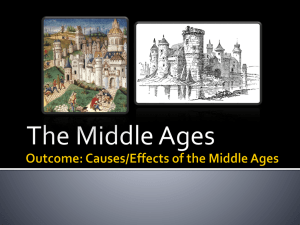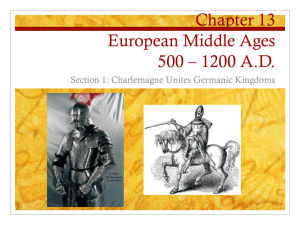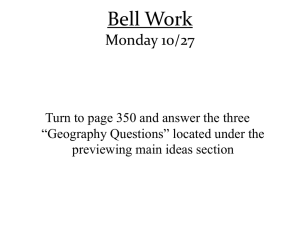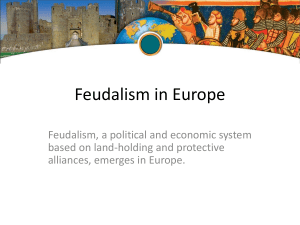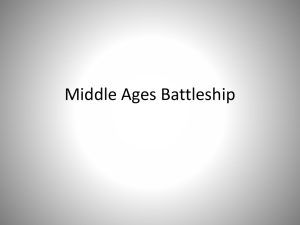Chapter 13 - Falconer Central School
advertisement
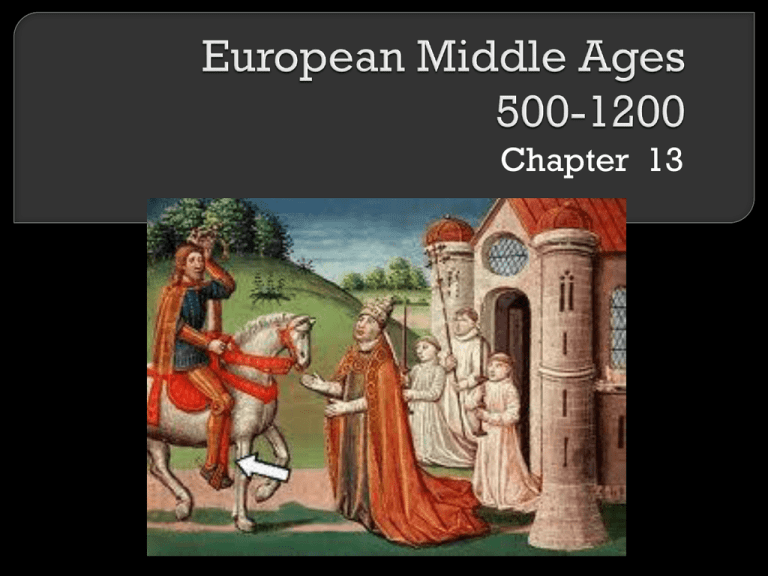
Chapter 13 Middle Ages: Era in Europe that followed the fall of the Roman Empire, lasted 500-1500. aka Medieval Period Franks: Germanic People who settled in France Feudalism: Political System, Nobles are granted lands that belong to the King, in exchange for their loyalty, military service and protection of the people who live on the land. Monastery: Religious group of monks. Given up possession for devotion to God. Secular: Separation from church/religion and state/government Lord: A person who controlled land and could grant estates to vassals Fief: An Estate granted to a vassal Vassal: A person granted land (Upper class) Knight: Warrior who followed Chivalry/protected people Serf: A person who is bound to the land and owned by the feudal lord Manor: A Lord’s estate Tithe: Payment of 1/10th of income to Church Chivalry: Code of Behavior for Knights, stressed courage, loyalty and religion Clergy: Religious officials who perform “rituals” Sacrament: Christian ceremonies in which God’s grace is transmitted to people Canon Law: Catholic religious laws Holy Roman Empire: An empire established Europe in the 10th century. Mainly in Germany and Italy. Chapter 13:1 1. Preserved the ideas of Rome (government, society) 2. Prolonging the Roman Catholic Church 1. Preserving the customs of the various Germanic (European) tribes 1. Disruption of Trade 1. 2. Downfall of Cities 1. 3. Lack of leadership in cities, independent farming lifestyle Decline of Learning 1. 2. 5. Cities no longer the epicenter of life/government Population Shifts to the Country Side 1. 4. Trade/culture diffusion became scarce Germanic Invaders were illiterate (Oral Traditions) lack of learning in the country side Loss of Common Language 1. Germanic Lang. mixed with Latin (French, Spanish) 400-600 A.D. small Germanic Kingdoms arise • Constantly at war with each other over land The Catholic Church provided stability and order (unified in their religion) Changes in Government • Emphasis on families/clans instead of central government and laws • Germanic Chiefs led warriors (lived with him) Clovis Rules the Franks • Brought Christianity to Franks (Constantine) • Supported by the R.C.C. (Why?) Franks converted thousands of people • More Catholics, more power to Rome • Spreading via Missionaries • Strength in numbers Monasteries, Convents and Manuscripts • Built in rural outposts • Benedict and Scholastica Books/rules for Monks/Nuns Papal Power Grows under Gregory I • Ruled outside of religion. Now Influenced Global Politics • Ruled all of Roman Europe • Church used taxes: armies, roads, poor ST. BENEDICT SCHOLASTICA Franks control the largest empire post Roman Empire Charles Martel Stopped the Muslim Expansion into Europe (Christian Hero) Martel’s Son is “Pepin the Short” • Works with the Pope • Establishes the Carolingian Dynasty 751-987 A.D. • Two sons: Carloman and Charles (Charlemagne: Charles the Great) Uniting Western Europe • Fought Muslims and Germanic Tribes • United for the 1st time since…..Rome • Larger than the Byzantine Empire (Largest in Europe) Crowned Holy Roman Empire • Put down mobs against Pope Leo III • Joined Germanic Kings, The Church and the heritage of the Roman Empire Limited Visited the power of Nobles every part of his kingdom Encouraged Opened Education schools (wealthy) Died 814, Louis the Pious (Bad Ruler) • Lothair, Charles the Bald, Louis the German • Treaty of Verdun • Divided kingdom into 3 areas 1. What were three roots of medieval culture in Western Europe? 1. What are three ways that civilizations in western Europe declined the Roman Empire fall? 1. What was the most important achievement of Pope Gregory I? Feudalism In Europe Chapter 13:2 Feudalism in Europe New Invasions Trouble Western Europe Vikings: Raiders, Traders, and Explorers Came from Scandinavia, also called Northmen or Norsemen Raided Western Europe, Russia and Constantinople from 800 1000 Explored areas west of the Atlantic such as Greenland, Iceland, and North America Skilled Traders/Merchants Ships enabled Vikings to sail/row up stream (3 ft) Constant warfare; people look in other directions for protection Vikings Muslims and Magyars Attack From the East and the South Muslims (Moors) Muslim armies conquered Southern Spain, and three major Italian islands Magyars (Nomads) Attacked in Eastern Europe Excellent Horsemen Controlled the Danube River to Northern Italy Feudalism Structures Society A New Social Order Invasions destroyed any central authority, people looked to anyone who could provide them protection Power based on relationships between a lord and a vassal System: King, Vassals (Nobles), Knights, Serfs/peasants Social Classes are Well Defined Serfs could not lawfully leave the land on which they worked Social class was inherited Bonded to land but were not slaves Labor/products belonged to the lord Feudalism Evolves Social Classes Are Well Defined Status determined perception of power/prestige Three Groups of People Fighters: Nobles and Knights Prayers: Clergy Workers: Peasants and Serfs Could not leave place they were born Bond to the land Could not be bought and sold Labor produced belonged to the land Manorial System: The Economic Side Feudalism Manor was the lords estate and basic economic system Set of Rights and Obligations between Lords and Serfs Lord Provided Housing Farmland Protection Serfs Provided Maintained the Lord’s land/animals Rarely traveled 25 miles from home (Fredonia) Lord’s house, church, workshops, 15-30 families, mills, streams Self-Sufficient Communities Raised of produced everything needed (dairy, clothing, lumber, produce) Outside purchases: Iron and salt Source: http://www.asmilan.org/teachers/kwheatley/maps/a_ medieval_manor.jpg Manors: The Economic Side of Feudalism A Self-Contained World A Manor was the lord’s estate Serfs worked the lord’s fields and performed other tasks in return for protection Serfs stayed on the same manor their whole lives The Harshness of Manor Life Peasants owed the lord three days labor and had to pay a percentage of their grain Serfs owed village priest a tithe, or 10% of income Avoiding taxes was a crime Weddings only with the Lord’s consent 1 Room cottages Dirt floors, Pigs, small fire 35 years old Illness and malnutrition God determined a person’s place in society The Age of Chivalry Chapter 13:3 Knights: Warriors on Horseback Leather saddles/stirrups (Asia 200 B.C.) Heavier weapons, more stable on horse Quick and swift on the battlefield Feudal Lords raised armies to protect their lands (Knights) Given Fiefs (Land) for their services 40 days of war (preparing for battle) Knighthood and the Code of Chivalry Set of rules and expectations Barely defend everyone Devote life to Lord and God Loyal, Brave and Courageous Training: (7-Page, 14-Squire, 21-Knight) Poetry idolized Knights life/Castles/Love The Song of Roland Women’s Role in Feudal Society Noblewomen Peasant Women Could own Property Endless Labor “Cushy Life” High Mortality Rate The Power of the Church Chapter 13:4 The Far-Reaching Authority of the Church Weak governments/kingdoms in Europe “There are two powers by which this world is chiefly ruled….” “Two Symbolic Swords:” Religious and Political Shaped the life of all people in all social classes The Church Religion As A Unifying Force Feudalism/Manorial System created class divisions Religion bonded people together Sense of security, belonging and community Salvation= Heaven Sacraments The Law Of The Church Authority was political and religious Canon Law unified spirituality and applied to all classes (Marriages/Sacraments) Excommunication/Interdict Used fear!! The Church Wields Power The Scope of Church Authority Religion as a Unifying Force Pope Bishops Clergy Priests Most everybody in Europe was a member of the same Church All people had an equal chance at salvation The Church and the Holy Roman Empire Otto The Great (Otto I) strong alliance with the Church Built power by allying himself with the Clergy Invaded Italy on the Pope’s behalf (Emperor) Holy Roman Empire The Church and the Holy Roman Empire Church Wields Religious and Political Power Pope Gregory VII banned lay investiture, the process where kings appointed church officials Excommunicated Concordat of Worms 1122: Only Pope could appoint church officials, emperor had veto power Disorder In The Empire The Reign of Fredrick I Attacked the surrounding Italian areas German States Remain Separate Alliance with the Church led to wars with neighbors Lombard League Weaker and weaker rulers Italian foot soldiers/crossbow Eventually collapsed defeated the German Knights ** Main Points** Church was the dominant power in Europe during the Middle Ages As time passes, emperors and kings struggle to weaken Church authority and gain power for themselves
